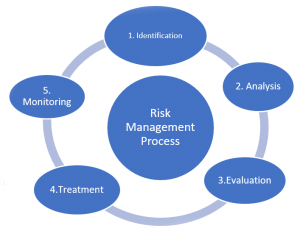What is Risk

Project risk is defined by The Project Management Institute as, “an uncertain event or condition that, if it occurs, has a positive or negative effect on a project’s objectives.” All projects involve risks, which leaders must evaluate and manage. To do this, it is necessary to identify risks and mitigate them, to ensure successful deliverables, controlled costs, and value added from the sponsor’s investment. Risk identification can be accomplished by evaluating the project against common risk categories:
- External:Government related, Regulatory, environmental, market related.
- Internal: Service related, Customer Satisfaction related, Cost related, Quality related.
- Technical:Any change in technology related.
- Unforeseeable: Some risks about 9-10% can be unforeseeable risks.
This process of risk analysis and identification is not only done at the beginning of the project, but also on a regular basis throughout the project lifecycle.
 EPMA Tips and Leading Practices
EPMA Tips and Leading Practices
A risk is something that could happen that would have a positive or negative effect on the project; an issue is something that has happened that is affecting the project.

Managing Risk
- Risk identification. The PM identifies and defines potential risks that may negatively influence a specific company process or project.
- Risk analysis. Once specific types of risk are identified, the PM determines the odds of it occurring, as well as its consequences.
- Risk assessment and evaluation. The risk is then further evaluated after determining the risk’s overall probability of occurrence combined with its overall consequence. The PM can then make decisions on whether the risk is acceptable and whether the company is willing to take it on based on its risk appetite.
- Risk treatment. During this step, companies assess their highest-ranked risks and develop a plan to mitigate them using specific risk controls.
- Risk monitoring. Part of the treatment plan includes following up on both the risks and the plan to uninterrupted monitor and track new and existing risks.
 EPMA Tips and Leading Practices
EPMA Tips and Leading Practices
Risk probability should range from 1% to 99%; a risk with 0% probability will not happen, and a risk with 100% probability should be logged as an issue.
Now that you have an idea about what is Risk Management, the part 2 will be about FAQ with Laura Holder, one of EPMA’S Certified Senior Project Manager around this subject, stay tuned!
At EPMA, our project managers have all the skills to enable your company to manage its customer portfolio but also to develop your performance and your risks management over the long term.
Do not hesitate to contact us for more information. Call us at 1.713.400.9200 or visit our website.
For more details & kick start your project management journey, sign up for our Microsoft Training Classes or send us an email.
I hope you find this blog post helpful. For more tips and tricks on Project Management, please visit www.epmainc.com

